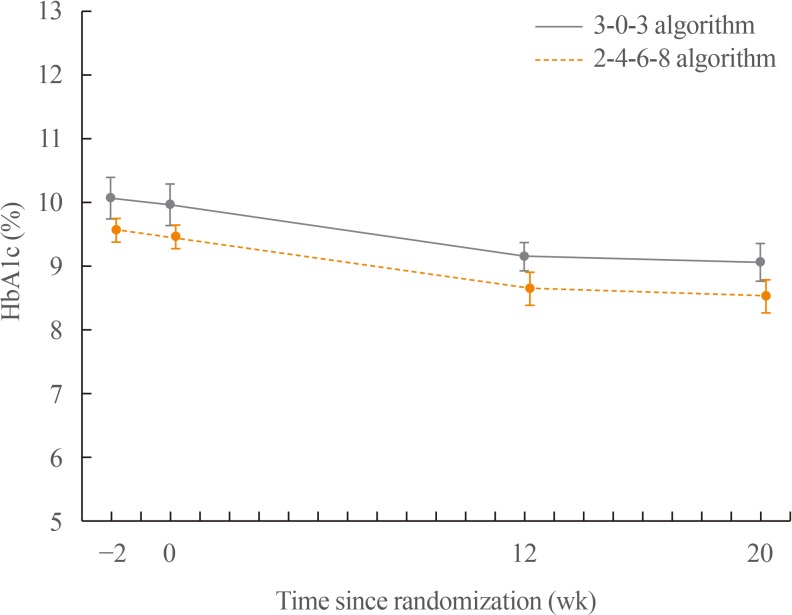Search
- Page Path
- HOME > Search
- Clinical Study
- Comparison of the Efficacy and Safety of Insulin Detemir Administered Once Daily According to Two Titration Algorithms (3-0-3 and 2-4-6-8) in Patients with Type 2 Diabetes Mellitus
- Hea Min Yu, Kang Seo Park, Jun Hwa Hong, Keun Yong Park, Jong Min Lee, Bon Jeong Ku, Yeo Joo Kim, Tae Kun Oh
- Endocrinol Metab. 2020;35(1):142-148. Published online March 19, 2020
- DOI: https://doi.org/10.3803/EnM.2020.35.1.142

- 4,717 View
- 80 Download
- 3 Web of Science
- 2 Crossref
-
 Abstract
Abstract
 PDF
PDF PubReader
PubReader  ePub
ePub Background This study was conducted to compare glycaemic control with insulin detemir administered according to two titration algorithms (3-0-3 and 2-4-6-8) after 20 weeks of treatment in subjects with type 2 diabetes mellitus inadequately controlled on metformin.
Methods This was a 20-week, randomised, multicentre, open-labelled, treat-to-target trial. Forty-six patients were randomised in a 1:1 manner to either the 3-0-3 (G3,
n =23) or 2-4-6-8 (G2,n =23) algorithm. The primary endpoint was change of haemoglobin A1c (HbA1c), and the secondary safety endpoint included hypoglycaemic events.Results After 20 weeks, HbA1c decreased similarly in the G3 and G2 groups, with a mean change of −0.9% from baseline. The mean change in fasting plasma glucose was numerically similar in both groups. The hypoglycaemia event rate per 100-patient-years of exposure (
r ) in the G2 group (r =1,427) was higher than that in the G3 group (r =807).Conclusion Both treatment groups had numerically similar HbA1c reductions. A trend towards fewer hypoglycaemia episodes after dose stabilisation was seen with the simpler G3. Clinically, this may be an important observation, as a simpler titration algorithm may support self-management and maintenance of insulin therapy.
-
Citations
Citations to this article as recorded by- Time for Using Machine Learning for Dose Guidance in Titration of People With Type 2 Diabetes? A Systematic Review of Basal Insulin Dose Guidance
Camilla Heisel Nyholm Thomsen, Stine Hangaard, Thomas Kronborg, Peter Vestergaard, Ole Hejlesen, Morten Hasselstrøm Jensen
Journal of Diabetes Science and Technology.2022; : 193229682211459. CrossRef - Efficacy and safety of patient-led versus physician-led titration of basal insulin in patients with uncontrolled type 2 diabetes: a meta-analysis of randomized controlled trials
Marco Castellana, Filippo Procino, Rodolfo Sardone, Pierpaolo Trimboli, Gianluigi Giannelli
BMJ Open Diabetes Research & Care.2020; 8(1): e001477. CrossRef
- Time for Using Machine Learning for Dose Guidance in Titration of People With Type 2 Diabetes? A Systematic Review of Basal Insulin Dose Guidance

- Bone Metabolism
- A Novel PHEX Gene Mutation in a Patient with Sporadic Hypophosphatemic Rickets
- Yea Eun Kang, Jun Hwa Hong, Jimin Kim, Kyong Hye Joung, Hyun Jin Kim, Bon Jeong Ku, Koon Soon Kim
- Endocrinol Metab. 2014;29(2):195-201. Published online June 26, 2014
- DOI: https://doi.org/10.3803/EnM.2014.29.2.195
- 3,774 View
- 34 Download
- 5 Web of Science
- 4 Crossref
-
 Abstract
Abstract
 PDF
PDF PubReader
PubReader Phosphate regulating gene with homologies to endopeptidases on the X-chromosome (PHEX) is a common cause of X-linked hypophosphatemic (XLH) rickets. Diverse
PHEX gene mutations have been reported; however, gene mutations in sporadic rickets are less common than in XLH rickets. Herein, we describe a 50-year-old female patient with sporadic hypophosphatemic rickets harboring a novel splicing-site mutation in thePHEX gene (c.663+1G>A) at the exon 5-intron 5 boundary. The patient had recently suffered from right thigh pain and an aggravated waddling gait. She also presented with very short stature, generalized bone pain, and muscle weakness. Despite low serum phosphate levels, her phosphate reabsorption rate was lower than normal. Additionally, her 1,25-dihydroxyvitamin D3 concentration was lower than normal, although FGF23 level was normal. After treatment with alfacalcidol and elemental phosphate, her rachitic symptoms subsided, and callus formation was observed in the fracture site on the right femur.-
Citations
Citations to this article as recorded by- A pathogenic PHEX variant (c.1483-1G>C) in a Korean patient with X-linked hypophosphatemic rickets
In Hwa Jeong, Jae-Ho Yoo, Namhee Kim
Annals of Pediatric Endocrinology & Metabolism.2021; 26(2): 130. CrossRef - A novel de novo mosaic mutation in PHEX in a Korean patient with hypophosphatemic rickets
Misun Yang, Jinsup Kim, Aram Yang, Jahyun Jang, Tae Yeon Jeon, Sung Yoon Cho, Dong-Kyu Jin
Annals of Pediatric Endocrinology & Metabolism.2018; 23(4): 229. CrossRef - Rodzinna krzywica hipofosfatemiczna – opis przypadku i przegląd literatury
Agnieszka Jędzura, Omar Bjanid, Piotr Adamczyk, Krzysztof Plesiński, Karolina Klimaszewska-Adamus, Maria Szczepańska
Pediatria Polska.2015; 90(5): 437. CrossRef - Articles in 'Endocrinology and Metabolism' in 2014
Won-Young Lee
Endocrinology and Metabolism.2015; 30(1): 47. CrossRef
- A pathogenic PHEX variant (c.1483-1G>C) in a Korean patient with X-linked hypophosphatemic rickets


 KES
KES

 First
First Prev
Prev



